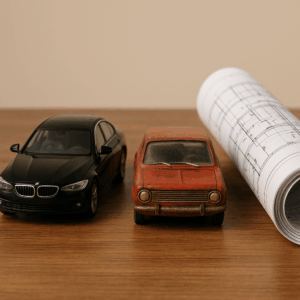
What do your clients really buy from you? As engineers, we often believe we are selling knowledge, experience, or creativity. We attend meetings, offer guidance, and answer questions, and it feels like these conversations are the value we provide. But the truth is, clients do not leave the table holding our ideas or our explanations. They leave with the plans or the report. That is the product they paid for.
And just like any product, it leaves a lasting impression.
Why Civil Engineers Must See Their Plans as Products, Not Just Services
Imagine spending $100,000 on a new car. When you open the door, you expect it to feel solid and smell new. You expect the dashboard to be clean and intuitive, the engine to run smoothly, and the paint to be flawless. If you spent that kind of money and the door handle broke off or the radio was held on with duct tape, you would be furious. Civil engineering plans are no different. A client who pays six figures for a set of construction plans expects them to look and function like they are worth six figures.
Unfortunately, some engineers miss this mindset. I have worked with other firms where the attitude was, “We will deal with it during construction.” In other words, let the contractor figure it out when the time comes. I completely disagree with this approach. Poorly thought-out or unclear plans cause unnecessary change orders, construction delays, stress, and ultimately added cost for the client. Worse yet, they damage trust. Even if the client liked working with you personally, they will remember that the product you delivered was flawed.
And the next time they need plans, they will shop elsewhere.
The Product Mindset for Engineers
I don’t often share this mentality with clients. I might say, “We are delivering a tool to help you make decisions,” or something similar. But the real value in this mindset is not just for clients, it is for my team. I push my staff to see the plans we produce as the product. Not an internal draft. Not just a stack of sheets. A product; and not just any product, the luxury model, not the beat-up used car.
Of course, this means the plans not only have to be technically accurate, they need to be complete, comprehensive, and clear. They should anticipate questions before they are asked. They should consider options that were evaluated and eliminated before the design decision was made. And they should present information clearly, using proper font sizes, clean drafting standards, and a logical flow of information that anyone on the construction site can follow.
Far too many plans these days are technically sufficient but visually confusing. Fonts clash, details overlap, and critical notes are buried or unreadable. When plans were drafted by hand, this sloppiness was rare. But today’s digital tools make it easy to reference and forget. The result can be poor product, no matter how smart the designer is.
Mentoring the Right Mindset
I do not leave this expectation to chance. I mentor and coach my team constantly. We talk about how the final deliverable reflects their personal reputation and mine. When I sign and seal their work, they represent my license and my name. That is not a burden. I see it as a privilege and a professional responsibility to foster my team to produce the same high quality work I would do if only I was working on it. While my name might be on it, they are the one’s who can take pride in the quality.
When working with other teams, I lead by example. I show them that producing a high-quality, high-value product is not only possible in a competitive market but also profitable. Clients will pay for a better product. More importantly, they will come back for it too.
If you are reading this to hear this message clearly: Your plans are your product. Not your time. Not your effort. Not even your expertise. The only thing the client holds in their hand when you are gone is that set of plans or that final report.
That is what they remember.
What Happens When Quality Slips
When engineers forget this, the consequences can be serious. Construction problems multiply. Costs go up. Trust erodes. But even beyond these short-term problems, the engineer’s reputation suffers. A client may tolerate a slow email response or a clunky meeting if the plans are excellent. But no amount of personal charm or relationship-building can make up for a poor product. If the product disappoints, the client leaves. If the product impresses, the client returns.
In my book, Rounding the Bases: Winning Communication and Leadership for Engineers, I emphasize the importance of clear, intentional communication. It is not just in how we speak, but in the work we deliver. Baseball teaches the same lesson. A batter may have a smooth swing and a great smile, but if he strikes out every time, the crowd will boo. Performance matters and your deliverables matter!
Your Next Project: The Product Test
So here is the challenge for every mid-career civil engineer reading this: The next time you finish a set of plans or a report, pretend you are the client. Would you feel like you just bought a luxury vehicle, carefully engineered and worth every dollar? Or would you feel like you drove off the lot in a cheap used car, wondering what corners were cut?
If you are not sure, take another pass. Improve the clarity. Clean up the layout. Ask a colleague to review it with fresh eyes. Because in the end, that product is the only lasting thing the client will have.
It is your chance to leave a lasting impression that goes far beyond your expertise.
Want to learn more about mastering client communication, leadership, and technical delivery? Check out my book, Rounding the Bases: Winning Communication and Leadership for Engineers, available now on Amazon. Or contact me to speak at your next company event or professional gathering. Helping engineers stand out and win in their careers is what I love to do.
If this resonates with you, let’s continue the conversation! Connect with me on LinkedIn.


